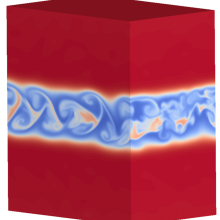Turbulence-chemistry interaction is of critical importance for the stabilisation of and pollutant formation in turbulent flames. Turbulence enhances the mixing of fuel and oxidiser in non-premixed combustion and therefore boosts combustion efficiency compared with laminar flames. However, very high levels of turbulence lead to excessive fluid strain being exerted on the flame front, which may result in local flame extinction and re-ignition phenomena and potentially even global flame blow-off. It is crucial to develop accurate modelling approaches that are able to capture such turbulence-chemistry interaction effects. In this project we use a stochastic sparse-Lagrangian particle implementation of the multiple mapping conditioning (MMC) framework to model turbulence-chemistry interaction in non-premixed flames. A number of stochastic particles smaller than the number of grid points is used to describe the state of the reacting scalar fields. To ensure accurate turbulent mixing MMC employs a reference variable that is used to select pairs of stochastic particles for mixing. To develop and validate the model, MMC is employed in two different frameworks for turbulence modelling, namely large eddy simulation (LES) and direct numerical simulation (DNS). The DNS case features extinction and re-ignition of a syngas (H2/CO/N2) flame in a double shear layer configuration and the DNS data serves as a validation reference for MMC. First, to test the predictive capability of MMC in the absence of potential errors associated with sub-models for LES, the DNS data is post-filtered at every time step and the such obtained LES-like quantities are used as inputs for MMC. In a second step, the syngas jet is simulated with a fully coupled MMC-LES approach, where mass, momentum and mixture fraction are transported in LES, whereas the reacting scalars are described by MMC. Coupling of MMC and LES is achieved by using the LES-filtered mixture fraction as the reference variable for MMC and by feeding the gas density corresponding to the MMC scalar fields back to the LES flow solver.
Movie 1:
Movie 1: Direct numerical simulation of syngas combustion in a double shear layer, where the fuel jet is initially located in the centre of the domain and surrounded by two counter-flowing oxidiser streams. After the start of the simulation the fuel and oxidiser streams mix and a turbulent flame forms. The mass fraction of the OH radical is taken as an indicator of the reaction zone and seen to first decrease (local extinction) from the burning initial condition and then increase again (re-ignition) during the simulation.
Movie 2:
Movie 2: Same simulation as in Movie 1, now showing the scalar dissipation rate (SDR). The scalar dissipation rate is proportional to the square of the scalar gradients and high levels of SDR are associated with high fluid strain and an increased likelihood of finding localised extinction.
Related publications
- S. Galindo-Lopez, F. Salehi, M. J. Cleary, A. R. Masri, G. Neuber, O. T. Stein, A. Kronenburg, A. Varna, E. R. Hawkes, B. Sundaram, A. Y. Klimenko, and Y. Ge, “A Stochastic Multiple Mapping Conditioning Computational Model in OpenFOAM for Turbulent Combustion,” Computers & Fluids, vol. 172, pp. 410–425, (2018).
- S. Vo, A. Kronenburg, O. T. Stein, and M. J. Cleary, “MMC-LES of a syngas mixing layer using an anisotropic mixing time scale model,” Combust. Flame, vol. 189, pp. 311–314, (2018).
- S. Vo, O. T. Stein, A. Kronenburg, and M. J. Cleary, “Assessment of mixing time scales for a sparse particle method,” Combust. Flame, vol. 179, pp. 280–299, (2017).
- S. Vo, A. Kronenburg, O. T. Stein, and E. R. Hawkes, “Direct numerical simulation of non-premixed syngas combustion using OpenFOAM,” in High Performance Computing in Science and Engineering ’16, Stuttgart, (2017), pp. 245–257.
- C. Straub, S. De, A. Kronenburg, and K. Vogiatzaki, “The effect of timescale variation in multiple mapping conditioning mixing of PDF calculations for Sandia Flame series D–F,” Combust. Theo. Mod., vol. 20, pp. 894–912, (2016).
- S. Vo, O. T. Stein, A. Kronenburg, and M. J. Cleary, “Analysis of MMC mixing model using DNS of an evolving double shear layer with extinction and reignition,” in Proc. 7th Europ. Combust. Meeting, Budapest, Hungary, (2015).
- K. Vogiatzaki, S. Navarro-Martinez, S. De, and A. Kronenburg, “Mixing Modelling Framework Based on Multiple Mapping Conditioning for the Prediction of Turbulent Flame Extinction,” Flow, Turbul. Combust., vol. 95, pp. 501--517, Oct. (2015).
- S. Vo, A. Kronenburg, O. T. Stein, Y. Ge, A. Y. Klimenko, and M. J. Cleary, “Analysis of LES-MMC modelling using DNS of a reacting mixing layer,” in 8th International Seminar on Flame Structure, Berlin, Germany, (2014).
Contact

Andreas Kronenburg
Univ.-Prof. Dr.Director of the Institute

Oliver T. Stein
Dr.former deputy director


